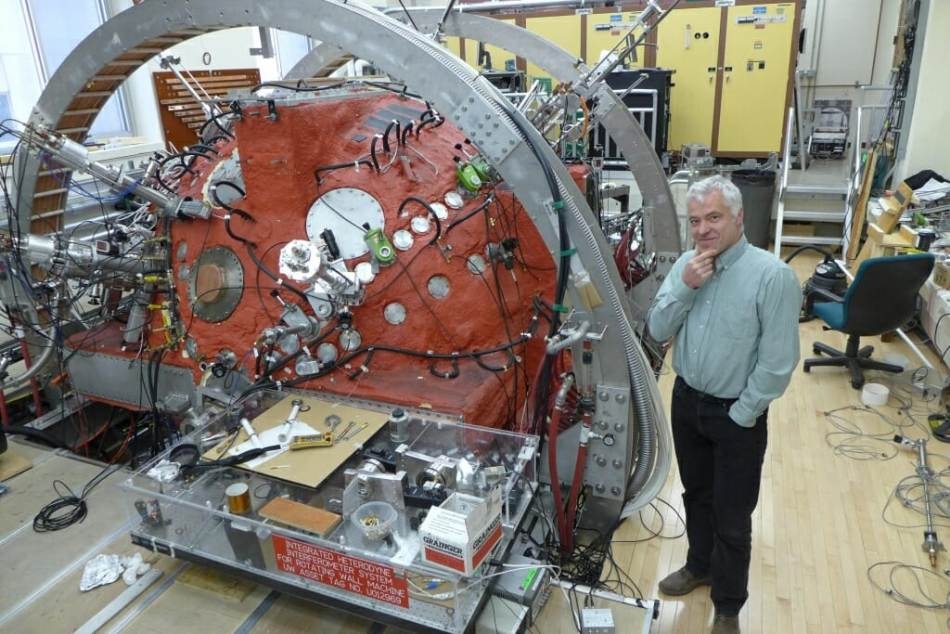Jan 31 2018
Physicists at the University of Wisconsin–Madison have reported unparalleled detail on a strange phenomenon that powers the solar flares, northern lights and coronal mass ejections (the biggest explosions in the solar system).
 Jan Egedal, Professor of physics at UW-Madison, stands beside a chamber used for experiments in that exotic phenomenon.(Image credit: David Tenenbaum/UW-Madison)
Jan Egedal, Professor of physics at UW-Madison, stands beside a chamber used for experiments in that exotic phenomenon.(Image credit: David Tenenbaum/UW-Madison)
The data on so-called “magnetic reconnection” was procured from a quartet of new spacecraft that measure magnetic fields and radiation in high Earth orbit.
“We’re looking at the best picture yet of magnetic reconnection in space,” says Jan Egedal, a professor of physics and senior author of a study in Physical Review Letters. Magnetic reconnection is tough to describe, but it can be vaguely defined as the merger of magnetic fields that discharges a surprising amount of energy.
Magnetic reconnection remains cryptic, especially since it “breaks the standard law” prevailing charged particles, or plasma, Egedal says.
Egedal and colleagues analyzed recordings from October 15, 2016, when the Magnetosphere Multiscale satellite passed via the point where the solar wind meets Earth’s magnetic field. “Our data clearly show that electrons suddenly cease to follow magnetic fields and zoom off in another direction, corkscrewing and turning. That begs for explanation,” Egedal says.
The activity established the theoretical descriptions of magnetic reconnection. But it sullied the regular law governing the behavior of plasmas – clouds of charged particles that comprise, for instance, the solar wind.
The ‘plasma frozen-in law’ says electrons and magnetic fields have to move together always, and suddenly that does not apply here. It’s the clearest example ever to be measured in space, and it blew my mind.
Our equations tell you reconnection cannot happen, but it does and our results show us which factors need to be added to the equations. When the law is violated, we can get an explosion. Even in Earth’s moderate magnetic field, reconnection from an area just 10 kilometers across can change the motion of plasma thousands of kilometers distant.
Jan Egedal
In the 1970s, telescopes orbiting above earth’s sheltering magnetic field and atmosphere started returning data on X-rays and other non-visible types of radiation. Rather rapidly, the age-old image of the sky as a quiet curtain of stars was pulled aside, exposing a zoo of weird objects, robust beams and cataclysmic explosions.
All of them had to be explained, and theorists started to concentrate on magnetic reconnection, which had been sketched out in 1956. At present, magnetic reconnection has been linked to:
- Black holes, ultra-dense objects with intense gravity that forbids even light from leaving
- Pulsars, which rotate hundreds of times a second and emit piercing beacons of light
- Supernovas, which discharge energy visible across the galaxies when they explode
- Active galactic nuclei, super-bright candles that are visible from billions of light years distance.
Almost everything we know about the universe comes from the light that reaches us. When one of these fantastic space telescopes sees a massive burst of X-rays that lasts just tens of milliseconds coming from an object in a galaxy far away, this giant burst of energy at such a great distance may reflect a massive reconnection event.
When neutron stars merge and give off X-rays, that’s magnetic reconnection. With these advanced orbiting telescopes, just about everything that’s interesting, that goes off suddenly, probably has some major reconnection element at its root.
Cary Forest, Professor of Physics at UW–Madison.
Magnetic reconnection also is the reasons for the auroras at both poles, Egedal says. When reconnection takes place on the sunward side of Earth, as was witnessed in the current study, “it changes the magnetic energy in the system. This energy migrates to the night side, and the same thing happens there, accelerating particles to the poles, forming auroras.”
Besides offering an understanding into the role of magnetic reconnection in celestial explosions, eruptions and bizarre emissions of energy, the observations have a practical side in terms of space weather: explosions of charged matter from the sun can destroy satellites and even electrical equipment on the ground. After a solar flare in 1989, for instance, the complete power system in Quebec went dark after it attracted a pulse of energy from space. “Across the United States from coast to coast, over 200 power grid problems erupted within minutes of the start of the March 13 magnetic storm,” NASA wrote.
Today, Forest notes, contemporary utility systems have switches to interrupt the loop of conductors that could become antennas that pick up a tricky pulse from the sun.
“If we understand reconnection better, perhaps we can improve space weather forecasts,” says Egedal. “We can look at the sun to predict what may happen in two to four days, which is how long the wind from the sun takes to reach Earth.”
Exploring Reconnection - Guide Field Off
This visualization shows the motion of a single electron undergoing magnetic reconnection. As the spacecraft approaches the reconnection region, it detects first high-energy particles, then low-energy particles. Credit: NASA